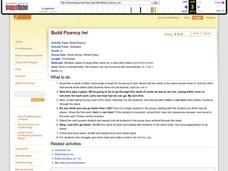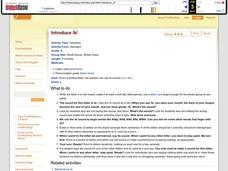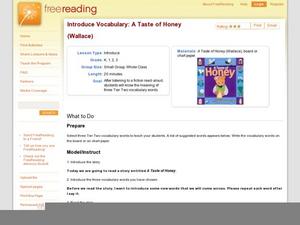Curated OER
Build Accuracy /a/, /m/
Make letter sounds a game for pre-readers using these letter cards. After you demonstrate, learners take turns drawing letters out of a bag. Weight them for the letters they have been practicing most recently. Once they've chosen a...
Curated OER
Introduce /t/
What sound does the letter t make? As scholars develop letter recognition, form sound associations with strategies like these. Explain the tongue movement in making the /t/ sound, asking learners to try it. Draw the t on the board and...
Curated OER
Introduce /r/
Use these inventive strategies to focus on the letter r, forming sound associations along with letter recognition. Explain the tongue movement in making the /r/ sound, asking learners to try it. Draw the r on the board and give examples...
Curated OER
Build Fluency /m/
Once kindergartners have learned the letter m they are ready for this sound correspondence activity. Start with a stack of letter cards including mostly m and a few other letters they haven't learned yet. Find these letter cards here for...
Curated OER
Reintroduce g
Synthesize pronunciation, recognition, letter sound, and word examples as scholars learn all there is about the letter g. They examine the letter shape and listen to you pronounce the hard /g/ sound. As you explain how this sound is...
Curated OER
Introduce Soft-C
Do your emerging readers know that letters sometimes borrow the sounds of other letters? Explore the soft /c/ sound, explaining that c has borrowed the sound from s. After giving scholars some examples of words that begin with this...
Curated OER
Introduce /k/
Explore the ins and outs of the letter k using these strategies combining pronunciation, letter recognition, and initial phoneme examples. Scholars examine the letter shape and listen to you pronounce the /k/ sound. Use these tips to...
Curated OER
Introduce /e/
Examine the most-used letter in the English language incorporating pronunciation, letter recognition, letter sound, and word examples for the letter e. Scholars examine the letter shape and listen to you pronounce the /eee/ sound. As you...
Curated OER
Reintroduce /c/
Do you c what I c? Use these strategies combining pronunciation, letter recognition, and initial phoneme examples to examine the letter c with kindergartners. Scholars examine the letter shape and listen to you pronounce the soft /c/...
Curated OER
Introduce /Q/
Everything your pre-readers need to know about the letter Q is right here; this strategy combines pronunciation, letter recognition, sound, and word examples. Scholars examine the letter shape and listen to you pronounce the /kwww/...
Curated OER
Introduce: Fact and Opinion
Build reading comprehension and critical-thinking skills as learners focus on discerning fact from opinion. First, introduce the two terms as you test prior knowledge and explain their meanings (there is a scripted explanation here for...
Curated OER
Introduce: Summarizing Narrative Text
When scholars re-tell a story, do they boil it down to important details in a logical order? Practice summarizing narratives using this think-aloud strategy, which is scripted here for your convenience. After explaining why this is an...
Curated OER
Build Mastery: Main Idea
Use a graphic organizer to get readers thinking about main ideas as they record the who, what, where, when, and why of a story. Consider modeling this process completely before kids do this independently. They fill in five boxes charting...
Curated OER
Build Mastery: Making Inferences
Do your youngsters realize that they are constantly making inferences? Expose this inner process by bringing out the book they will be reading. Ask scholars what they think the plan is, and explain that their answers are the product of...
Curated OER
Build Mastery: Purpose for Reading
Do you agree? Set up three stations in your room for this reading comprehension activity: I agree, I disagree, and I'm not sure. Learners listen to statements and walk to the sign that best describes their response. Model this with an...
Curated OER
Build Mastery: Cause and Effect
After you've begun identifying the cause and effect relationship within literature, it's time to give scholars some independent practice. Review the concept before handing out this graphic organizer. Learners use the book they are...
Curated OER
Build Mastery: Fact and Opinion
Is it a fact or an opinion? Get your kids up and moving during this reading comprehension activity. They listen to you read a book or passage (consider writing something yourself to get the ideal text), listening for facts and opinions....
Curated OER
Introduce Vocabulary: A Taste of Honey (Wallace)
A Taste of Honey offers learners a chance to practice with unknown words and context clues. Choose several vocabulary words to focus on as you read the picture book, or use the ones provided here. Pre-teach the words and have scholars...
Curated OER
Introduce Vocabulary: Peter's Chair (Keats)
A new baby means a lot of changes for Peter! Ezra Jack Keats presents this common childhood experience in his story Peter's Chair, the context of a detailed vocabulary study. Before you read, introduce the three new words scholars will...
BioEd Online
Gravity and Buoyancy
Would a baggie filled with water have the same shape sitting on a table as it would in a bucket of water? Why not? Allow learners to find out first-hand the effects of gravity acting alone on the baggie, as well as when gravity is...
Baylor College
Digestion
Digestion is an amazing and complicated process that provides humans with the energy they need to survive. Lesson six in this series on the science of food uses sliced turkey and a meat tenderizer to demonstrate how enzymes help break...
Baylor College
Safe Food Preparation
Who doesn't love ice cream? Make this delicious dessert with your class while learning about food preparation in the tenth lesson of this series. Teach about the importance of cleanliness and proper cooking techniques in order to avoid...
Baylor College
Making Copies of an HIV Particle
In the second of five lessons about HIV, discover the mechanisms that allow the HIV virus to replicate. Using the models that they created the day before, learners examine the parts of the virus particle. The lesson plan does not say...
Baylor College
Servings and Choices
An important part of balancing caloric intake to energy expenditure is knowing how many Calories you are consuming. In the fifth of a seven-lesson plan series on food and energy, learners estimate their daily caloric intake, then use a...
Other popular searches
- Consumer Price Index
- Bmi
- Index Fossils
- Using an Index
- Body Mass Index
- Air Quality Index
- Climate Index
- Air Quality Index Report
- Index Species
- Human Development Index
- Index Fossils Geologic Time
- Water Quality Index

























